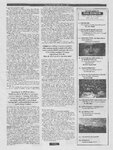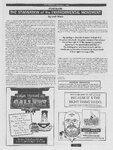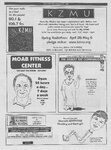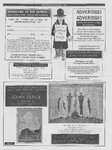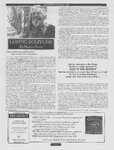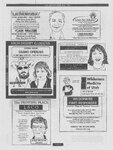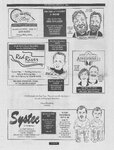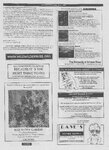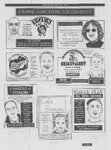| OCR Text |
Show THE ZEPHYR/ APRIL-MAY A THOUSA D MILES occasional stretch of sand. But like the Fraulein said...it’s the corrugation. on the ROAD to HELL in WESTERN 2006 THE GUNBARREL Photographs don’t do it justice. The Old Gunbarrel Highway looks like an easy two track sandy road—it’s flat as featureless as the land around it. No steep hills to climb. Only an AUSTRALIA This washboard road was like nothing we’d ever experienced. The ridges of corrugation were not tightly grouped the way the road to Chaco Canyon is, for example. You can’t gather speed and drive over the tops of the ridges. These ridges looked like gentle ocean waves, slowl undulating every 16 inches or so. Just enough distance between ridges to make high-speed traveling absolutely impossible. We tried to gain speed and it beat us and the ute and everything inside it to pieces. We discovered, in fact, that any speed over 10 mph was prohibitive. It could not be done. We were 300 miles from the nearest human, a ranch called Carnegie Station, and more my obligatory 4WD Adventure...by Jim Stiles than 600 miles from a paved road. We had no “macho” maneuvers ahead of us. This would be an adventure in endurance, we soon realized. Days of it. AUTHOR’S NOTE: This is more than my obligatory4WD adventure story. It’s not just my attempt to connect with the 4WD Culture, or to pull in a few extra readers during the exulted Jeep Safari Week. It is, in fact, an effort to show all of you 4WD wannabes what REAL adventure is like. As down pre-appointed rock ledges and cliffs, and with medical facilities just a cell phone that you are participating in an adventure. stupidity than that...JS adventure you drive your $50,000 extravaganzas up and with dozens of bystanders to watch and assist, call away, I laugh...yes LAUGH at the notion You have got to be kidding. It takes a lot more The temperature reached 105. The road rarely deviated from a straight line. From one of my Aussie history books, I learned that Beadell and his work crew had built the road in the 50s in the course of just a few months. It was a Cold War project—an evacuation road of sorts and only the second route (at the time) that crossed the Australian continent. They called it the Gunbarrel Highway because it was as straight as a gunbarrel. There was no Reggie Gubbins and I were into the second fier of our cross-continental Australia journey and frankly, we’d had a gutful of each other. He’d picked me up at the Sydney airport on New Year’s Day in his “1981 Toyota Diesel 4WD Dual cab Ute with a canopy,” and within an hour we were on the road, albeit the left side, going south along the coast. We'd been camping ever since. I had spent all of that driving time on the left side, the passenger side of the ute. From the start Reggie was reluctant to allow me behind the wheel. He was very protective of the vehicle and even s¢ olded me once for putting a wool sock on the hood. “Would you please move that?” he exclaimed in his distinctive high -pitched Welsh accent, “You might scratch the surface!” He really loved that ute and could not bear to even get it dirty. As for my driving, Reggie feared I might hit a kangaroo and had given me some rudimentary instructions for avoiding collisions with our pouched friends. Primarily he insisted that we never drive more than 80 km/h our (about 48 mph). I reminded him that since he’d once run my ex-wife’s Pinto off a cliffa t Arches National Park while in a drunken stupor and totaled it, | was very well within my rights to hit a kangaroo, just for spite. (Of course I would have never done that to the ‘roo.) But the vague threat troubled Reggie, even when I told him I was joking, and subsequently, I was confined to the navigator’s seat. REACHING THE RED CENTER Now, after some excruciating washboard ra ads east of Alice Spring, we had finally reached the Red Center of Australia and Uluru—Ayer’s Rock to us white folks. We planned to hike to its summit and rose early to beat the h eat, but found ourselves in a queue with about 5000 Japanese tourists who had also arrived before dawn. The climb was difficult and steep, but the view on top was stunning, when | could see past the bobbing heads of my fellow travelers, posing for endless photos of one another. Unlike a mountaintop view here, that exp d fridges and fi s and meadows and mountains, the view from atop Uluru was striking for its monotony. Except for the Olgas, an outcrop of } Lh: a: sandstone 80 kms west. The horizon was as flat an d featureless as western Kansas. We were heading into flat country. The plan all along had been to go west on dirt roads that would take us almost 1000 miles through some of the most unpopulated co untry in Australia. Except for occasional roadhouses, “services” did not exist. West of the Giles Weather Station, we originally intended to travel southwest along the Great Central Road to the mining town of Kalgoorlie in Western Australia, then south to the coast at Esperance. But as we drank a cup of tea and loaded the ute, Reggie proposed a change. “I think we should be totally MACHO (pronounced ‘match-a “in Welsh) and take the north road—the OLD Gunbarrel Highway!” he exclaimed. “It'll be something to remember!” I checked the map and found the divide, whi ere the Great Central road turned to the southwest. The Old Gunbarrel Highway, planned and constructed by Aussie Legend Lem Beadell after World War II, wound to the northw est, toward Wiluna. It looked barren and : im. 2 “What about the road?” I asked. “We know no thing about it.” “No worries,” said Reggie. “No wuckin’ furri es. No Davey Murrays.” He was sure it would be just fine. “But this takes us away from the south coast an d from Esperance,” I complained. “And what about Albany and Walpole? We won't see a iny of that.” Reggie was adamant. “Nobody does the Gunba rrel in the heat of summer...nobody. You always want to get away from the crowds. Here’s your chance.” I could hardly argue with that. And it was his car. And he turned out to be right...or almost. Almost nobody drives the Gunbarrel in the heat of summer. But just to be safe, Reggie called the police at Wiluna, at the far we st end of the Gunbarrel, just to let them know we were coming. “This way,” said Reggie “Sf anything goes wrong, they'll come looking for us. I feel safer already.” We tried to fill the petrol tank at Warburton, an Aboriginal community that did not allow whites to enter—they’d had enough of us—but a road house on the outskirts of town provided limited services. Somehow we forgot to fill the water bottles (sort of a bad move) but we spotted a bore pump on the map, 30 kms ahead. It took a bit of priming but we finally established a decent flow of brackish water. Neither of us had wanted to invest in water containers so we saved all our plastic pop bottles and managed to fill them all. Just beyond the pump, the road forked. It was Reggie's last chance to change his mind, but he seemed determined. January in Western Australia is mid-summer. Temperatures climb above 100 degrees and the humidity may reach 80%. With conditions like this, we made the turn onto the Gunbarrel Highway—I didn’t feel “matcho” at al l. Reggie and! had only traveled a few miles down the Gunbarrel when we saw a vehicle coming our way—it would be the only car we’d see for almost a week. It was a wellequipped Land Rover, one of those BritsAustral ia rentals that comes with a plethora of accessories including a snorkel on its carburet ior; we flagged them down. We were concerned about the quality of the road—were th rere sand dunes ahead, we asked? Road washouts? Deep ravines and tricky ledges? The c« puple, German, think, shook their heads wearily. None of those obstacles posed a problemi it would appear. But repeatedly, they said, “Corrugation....corru igation,” in a dull monotone. As if a little washboard road would be a problem for us. We breathed a sigh of relief and waved merrily to the young Germans who could barely muster a smile. What was their problem, we wondered? A few minutes later, we found out. "What about the road?" | asked. "We know nothing about it.” "No worries," said Reggie. "No wuckin' furries. No Davey Murrays." He was sure it would be fine. reason not to go straight...there were no obstructions. Nothing. But there were flies. The Australian bush flies, to be exact, which greeted us each morning at first light innumbers that conjured memories of horror movies and bad dreams. But this was really happening/\t was impossible to answer the call of Nature, once the sky began to lighten in the east. The flies loved bare bottoms at dawn. And so we developed our routine. We'd awaken by 4am, go to the great outdoor toilet (being careful to avoid the spiny cactus-like spinifex which grew abundantly), strike the tents, gulp down a quick cup of tea, then start our 10 mph daily 16 hour drive. Reggie still wouldn’t allow me behind the wheel, despite our limited speed. It would have been impossible to run over a kangaroo; under these circumstances, we couldn’t even keep up with one, but Reg insisted. He began to nod off from time to time and the ute would drift to one side of the road, hit the embankment and bounce back to the middle. We must have looked like a carnival bumper car to the wedgetail eagles floating on invisible thermals, far above. We both began to hallucinate and exhibit strange behavior. At one point, the bouncing awakened me from a deep sleep and I swore he’d run over a giant lizard...a heath monitor perhaps or a giant gowanna. About five minutes laterI said, “Did you see that giant lizard? You may have run over it.” Reggie slammed on the brakes, we skidded to a stop and he leapt from the car. “I don’t believe it!” he yelled and began to.run up the road from whence we'd just come, in search of the giant lizard. A half hour later he returned, glassy-eyed and stumbling. “I didn’t see any damn lizard,” he mumbled as he climbed back in the ute. We drove on. On the fifth day, storm clouds gathered west of us and we could see lightning bolts strike the distant spinifex plain. “I hope it pisses down rain!’ Reggie exclaimed. The next morning we began to encounter puddles but could never catch the rain itself. The temperature hovered above 100 degrees but the humidity was overwhelming us. As we rattled along, I noticed something odd-my jeans had expanded at the waist; when I stood up they practically slid off my hips. Later I realized I’d lost 15 pounds just sitting in the front passenger seat of Reggie’s ute, bouncing up and down, 16 hours a day in 100 degree heat. The Gunbarrel Weight Loss Program-—I don’t recommend it. Beene acme |


